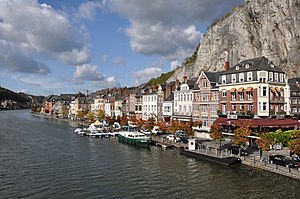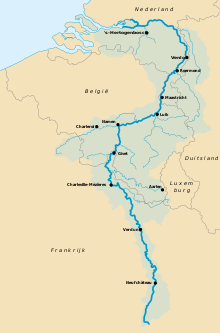| Meuse Meuse (French) Moûze (Walloon) Maas (Dutch) Maos (Limburgish) | |
|---|---|
 The Meuse at Dinant | |
 Basin of the Meuse | |
| Location | |
| Country | France, Belgium, Netherlands |
| Region | Western Europe |
| Cities | Verdun (France), Sedan (France), Charleville-Mézières (France), Namur (Belgium), Liège (Belgium), Maastricht (Netherlands), Venlo (Netherlands), Rotterdam (Netherlands) |
| Physical characteristics | |
| Source | |
| - location | Pouilly-en-Bassigny, Le Châtelet-sur-Meuse, Haute-Marne, Grand Est, France |
| - coordinates | 47°59′12″N 5°37′00″E / 47.9867°N 5.6167°E |
| - elevation | 409 m (1,342 ft) |
| Mouth | North Sea |
| - location | Hollands Diep, Noord-Brabant/Zuid-Holland, Netherlands |
| - coordinates | 51°42′54″N 4°40′04″E / 51.715°N 4.6678°E |
| - elevation | 0 m (0 ft) |
| Length | 925 km (575 mi) |
| Basin size | 34,548 km2 (13,339 sq mi) |
| Discharge | |
| - average | 350 m3/s (12,000 cu ft/s) |
| [1] | |
The Meuse (Dutch: Maas) is a river in Western Europe. The river starts in France, goes through Belgium and the Netherlands. It ends in the North Sea.[2] The Meuse is fed mostly by rainwater.[3] It is the oldest river in the world.